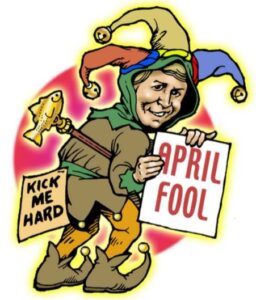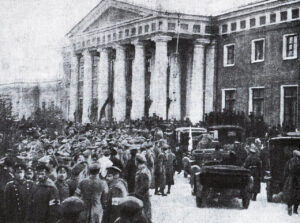julian calendar

 Some historians speculate that April Fools’ Day actually dates back to 1582, when France switched from the Julian calendar to the Gregorian calendar. This wasn’t a popular change with everyone, and some people just forgot it was going to happen. Nevertheless, the Council of Trent called for it to happen in 1563. Those who accepted the change and of course, the Council of Trent were not sympathetic to those who didn’t cooperate. People who were slow to get the news or failed to recognize that the start of the new year had moved to January 1 and continued to celebrate it during the last week of March through April 1 became the butt of jokes and hoaxes. I don’t suppose that first April Fools’ Day was so fun for the victims of the hoaxes in 1563. Those people were really being ridiculed.
Some historians speculate that April Fools’ Day actually dates back to 1582, when France switched from the Julian calendar to the Gregorian calendar. This wasn’t a popular change with everyone, and some people just forgot it was going to happen. Nevertheless, the Council of Trent called for it to happen in 1563. Those who accepted the change and of course, the Council of Trent were not sympathetic to those who didn’t cooperate. People who were slow to get the news or failed to recognize that the start of the new year had moved to January 1 and continued to celebrate it during the last week of March through April 1 became the butt of jokes and hoaxes. I don’t suppose that first April Fools’ Day was so fun for the victims of the hoaxes in 1563. Those people were really being ridiculed.
With such a start, to this unique day, April Fools’ Day seems like it was really a cruel day, not the fun day we know today. Nevertheless, the idea of jokes and pranks is one that a lot of people could get onboard with…it’s almost as good as a tickle torture to make people laugh. Yes, there is a victim, but it’s all in good fun. The  English agreed, and on April 1, 1700, it began. English pranksters collectively decided to make April Fools’ Day or All Fools’ Day, as it was also called, an annual tradition by playing practical jokes on each other. It has been celebrated for several centuries by different cultures now.
English agreed, and on April 1, 1700, it began. English pranksters collectively decided to make April Fools’ Day or All Fools’ Day, as it was also called, an annual tradition by playing practical jokes on each other. It has been celebrated for several centuries by different cultures now.
Favorite pranks included having paper fish placed on the victims’ backs and being referred to as poisson d’avril (April fish), said to symbolize a young, “easily hooked” fish…basically a gullible person. April Fools’ Day spread throughout Britain during the 18th century. In Scotland, the tradition became a two-day event, starting with “hunting the gowk” (gowk is a word for cuckoo bird, a symbol for fool), in which people were sent on phony errands and followed by Tailie Day, which involved pranks played on people’s derrieres, such as pinning fake tails or “kick me” signs on them. And I thought the pranks played these days were unique.
These days, lots of people get into the action. Everything from telling someone they had a spider in their hair to the really good pranksters, who can really get their victims going. My own family, when I was a kid growing up, 
 were dedicated pranksters. Things like switching the salt and sugar were a common prank, and even used on days other than April Fools’ Day. Of course, we tried things like a spider in your hair, a rip in your jeans, and such, but we were never mean about it. So, in the end, a day which was meant to really humiliate, has turned into a prankster’s holiday, and most people are good natured about it, and simply have a few great laughs. Happy April Fools’ Day everyone. Let the pranks begin and continue!!
were dedicated pranksters. Things like switching the salt and sugar were a common prank, and even used on days other than April Fools’ Day. Of course, we tried things like a spider in your hair, a rip in your jeans, and such, but we were never mean about it. So, in the end, a day which was meant to really humiliate, has turned into a prankster’s holiday, and most people are good natured about it, and simply have a few great laughs. Happy April Fools’ Day everyone. Let the pranks begin and continue!!
 How can the February Revolution begin on March 8th, you might ask? Well, if you know much about 1917 Russia, you know that the calendar at that time was the Julian calendar, and not the Gregorian calendar that we use today in most countries. That was how the February Revolution (known as such because of Russia’s use of the Julian calendar) which began on February 23rd in the Julian calendar, actually began on March 8th in the now-used Gregorian calendar. The February Revolution started with riots and strikes over the scarcity of food erupt in Petrograd. One week later, centuries of czarist rule in Russia ended with the abdication of Czar Nicholas II, and Russia took a dramatic step closer to a communist revolution.
How can the February Revolution begin on March 8th, you might ask? Well, if you know much about 1917 Russia, you know that the calendar at that time was the Julian calendar, and not the Gregorian calendar that we use today in most countries. That was how the February Revolution (known as such because of Russia’s use of the Julian calendar) which began on February 23rd in the Julian calendar, actually began on March 8th in the now-used Gregorian calendar. The February Revolution started with riots and strikes over the scarcity of food erupt in Petrograd. One week later, centuries of czarist rule in Russia ended with the abdication of Czar Nicholas II, and Russia took a dramatic step closer to a communist revolution.
By 1917, Czar Nicholas II had already lost all of his credibility. The corruption in the government was rampant, the economy was a mess, and Nicholas repeatedly dissolved the Duma…the Russian parliament established after the Revolution of 1905…whenever it opposed his will. All that was bad, but the immediate cause of the February Revolution, which was the first phase of the Russian Revolution of 1917…was Russia’s disastrous involvement in World War I. Militarily, Russia was no match for industrialized Germany, and Russian casualties were greater than those sustained by any nation in any previous war. They were severely pounded by the Germans. Meanwhile, the economy was hopelessly disrupted by the costly war effort, and moderates joined Russian radical elements in calling for the overthrow of the czar, who was already weak due to family problems, namely a sick child.
While most of the world switched from the Julian calendar to the Gregorian calendar in 1582, Russia didn’t make the conversion until 1918. So, 104 years ago, the Russian people irrevocably had half a month wiped out of their lives…13 days of February in 1918. Their calendar went from January 31, 1918, to February 14, 1918…overnight. On March 8th or February 23rd, 1917, depending on the calendar you choose to use for the event, demonstrators were clamoring for bread in the streets of the Russian capital of Petrograd (now known as Saint Petersburg). Supported by 90,000 men and women on strike, the protesters clashed with police but refused to leave the streets. The strike spread, and on March 10th, it had spread among all of Petrograd’s workers, and irate mobs of workers destroyed police stations. Several factories elected deputies to the Petrograd Soviet, or “council” of workers’ committees, following the model devised during the Revolution of 1905.
By March 11th, the troops of the Petrograd army garrison ordered soldiers to crush the uprising. Regiments opened fire, killing demonstrators, but the protesters kept to the streets, and the troops began to waver. Nicholas dissolved the Duma again on that day, and on March 12, the revolution triumphed when regiment after regiment of the Petrograd garrison defected to the cause of the demonstrators. The soldiers, some 150,000 men, subsequently formed committees that elected deputies to the Petrograd Soviet.
The uprising forced the imperial government to resign, and the Duma formed a provisional government that peacefully vied with the Petrograd Soviet for control of the revolution. March 14th, saw the Petrograd Soviet  issuing “Order No. 1,” which instructed Russian soldiers and sailors to obey only those orders that did not conflict with the directives of the Soviet. Czar Nicholas II abdicated the throne the next day, March 15th, in favor of his brother Michael, who refused the crown, ending the czarist autocracy.
issuing “Order No. 1,” which instructed Russian soldiers and sailors to obey only those orders that did not conflict with the directives of the Soviet. Czar Nicholas II abdicated the throne the next day, March 15th, in favor of his brother Michael, who refused the crown, ending the czarist autocracy.
The Petrograd Soviet tolerated the new provincial government and hoped to salvage the Russian war effort while ending the food shortage and many other domestic crises…a daunting task. Meanwhile, Vladimir Lenin, leader of the Bolshevik revolutionary party, left his exile in Switzerland and crossed German enemy lines to return home and take control of the Russian Revolution.

